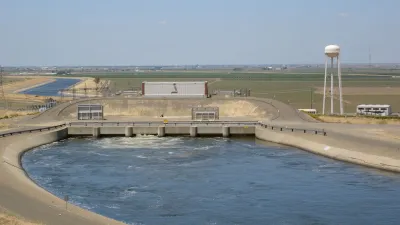Legislation to reauthorize the California Global Warming Solutions Act of 2006 is in peril due to 'a powerful bloc of business-friendly Democrats' who are uneasy about its impact on businesses, particularly Big Oil, due to higher energy costs.

"Senate Bill 32 is shaping up as the biggest fight lawmakers are likely to tackle in what remains of the legislative year," reports Laurel Rosenhall for CALmatters, a nonprofit journalism venture dedicated to exploring state policy and politics.
It pits environmentalist Democrats, mostly from the state’s more prosperous coastal areas, against Democrats and Republicans from struggling inland areas who side with oil companies and other businesses, and whose constituents could be harder hit by rising energy prices.
"This bill would require the state board to approve a statewide greenhouse gas emissions limit that is equivalent to 40% below the 1990 level to be achieved by 2030," according to the latest version of the bill, amended from when it was last posted here after the bill failed to pass last year.
As posted initially, SB 32 picks up where AB 32, the California Global Warming Solutions Act of 2006, ends in 2020. Both bills were written by Fran Pavley, now state Senator (D-Agoura Hills, Los Angeles County).
An ominous sign is that the Speaker of the Assembly, Anthony Rendon (D-Paramount, Los Angeles County) stated "earlier in the week that 'it’s not imperative' the bill clear his house this year," reports Rosenhall. However, in an Aug 4 press release, he wrote, "As Senate President pro Tem de Leon noted yesterday and the Governor’s office reiterated today, we are committed to extending California’s emission targets beyond 2020, and we will keep working on this until it’s right.”
Back-up plans:
- [The California Air Resources Board (CARB)], largely made up of Brown appointees and beyond the Legislature’s control, is already at work on a Plan B—drafting rules that could act as a back-up for Brown’s environmental agenda in case SB 32 withers.
- [Gov. Jerry Brown] on [July 28] opened a fundraising committee, taking the first step toward putting an environmental initiative on the 2018 ballot in case the bill fails in the Legislature.
Polling shows support for SB 32
"When asked about this proposal, 68 percent of adults and 59 percent of likely voters favor it," according to a new Public Policy Institute of California poll released July 28. "Across parties, Democrats (78%) are twice as likely as Republicans (39%) to favor the expanded goals (59% independents in favor)."
Future of cap-and-trade program
David R. Baker, clean tech and energy reporter for the San Francisco Chronicle, reports on the same topic, with a strong focus on the cap-and-trade program which was authorized by the 2006 legislation.
Debate rages over whether the system, which forces businesses to buy a permit for every ton of greenhouse gases they spew into the atmosphere, has any legal authority to continue operating past 2020. California air-pollution regulators, who created the system, insist that it does. The state’s legislative counsel argues otherwise.
Current litigation a threat as well
Meanwhile, a lawsuit from the California Chamber of Commerce charges that the permit fees are a tax and should have required a two-thirds vote in the Legislature to take effect. Although the suit has dragged on for nearly four years, questions raised by an appeals court judge in April suggested that he might side with the chamber.
With the uncertainty surrounding SB 32 and the future of the cap-and-trade program, revenues from May's quarterly auction of carbon permits were less than two percent of what what was projected.
FULL STORY: Climate retreat? Legislature could ditch plan to radically cut emissions

National Parks Layoffs Will Cause Communities to Lose Billions
Thousands of essential park workers were laid off this week, just before the busy spring break season.

Retro-silient?: America’s First “Eco-burb,” The Woodlands Turns 50
A master-planned community north of Houston offers lessons on green infrastructure and resilient design, but falls short of its founder’s lofty affordability and walkability goals.

Delivering for America Plan Will Downgrade Mail Service in at Least 49.5 Percent of Zip Codes
Republican and Democrat lawmakers criticize the plan for its disproportionate negative impact on rural communities.

Test News Post 1
This is a summary

Test News Headline 46
Test for the image on the front page.

Balancing Bombs and Butterflies: How the National Guard Protects a Rare Species
The National Guard at Fort Indiantown Gap uses GIS technology and land management strategies to balance military training with conservation efforts, ensuring the survival of the rare eastern regal fritillary butterfly.
Urban Design for Planners 1: Software Tools
This six-course series explores essential urban design concepts using open source software and equips planners with the tools they need to participate fully in the urban design process.
Planning for Universal Design
Learn the tools for implementing Universal Design in planning regulations.
EMC Planning Group, Inc.
Planetizen
Planetizen
Mpact (formerly Rail~Volution)
Great Falls Development Authority, Inc.
HUDs Office of Policy Development and Research
NYU Wagner Graduate School of Public Service


























